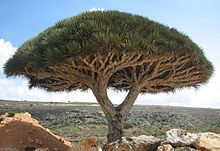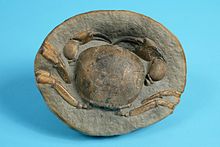
Miocene
Did you know...
This Schools selection was originally chosen by SOS Children for schools in the developing world without internet access. It is available as a intranet download. See http://www.soschildren.org/sponsor-a-child to find out about child sponsorship.
| System | Series | Stage | Age ( Ma) | |
|---|---|---|---|---|
| Quaternary | Pleistocene | Gelasian | younger | |
| Neogene | Pliocene | Piacenzian | 2.588–3.600 | |
| Zanclean | 3.600–5.332 | |||
| Miocene | Messinian | 5.332–7.246 | ||
| Tortonian | 7.246–11.608 | |||
| Serravallian | 11.608–13.65 | |||
| Langhian | 13.65–15.97 | |||
| Burdigalian | 15.97–20.43 | |||
| Aquitanian | 20.43–23.03 | |||
| Paleogene | Oligocene | Chattian | older | |
| Subdivision of the Neogene Period according to the IUGS, as of July 2009. | ||||
The Miocene (symbol MI) is a geological epoch of the Neogene Period and extends from about 23.03 to 5.332 million years ago (Ma). The Miocene was named by Sir Charles Lyell. Its name comes from the Greek words μείων (meiōn, “less”) and καινός (kainos, “new”) and means "less recent" because it has 18% fewer modern sea invertebrates than the Pliocene. The Miocene follows the Oligocene Epoch and is followed by the Pliocene Epoch. The Miocene is the first epoch of the Neogene Period.
The earth went from the Oligocene Epoch through the Miocene and into the Pliocene as it cooled into a series of Ice Ages. The Miocene boundaries are not marked by a single distinct global event but consist rather of regional boundaries between the warmer Oligocene and the cooler Pliocene.
The plants and animals of the Miocene were fairly modern. Mammals and birds were well-established. Whales, seals, and kelp spread. The Miocene Epoch is of particular interest to geologists and palaeoclimatologists as major phases of Himalayan Uplift had occurred during the Miocene Epoch affecting monsoonal patterns in Asia, which were interlinked with Northern Hemisphere glaciation.
Subdivisions
The Miocene faunal stages from youngest to oldest are typically named according to the International Commission on Stratigraphy:
| Messinian | (7.246–5.332 Ma) |
| Tortonian | (11.608–7.246 Ma) |
| Serravallian | (13.65–11.608 Ma) |
| Langhian | (15.97–13.65 Ma) |
| Burdigalian | (20.43–15.97 Ma) |
| Aquitanian | (23.03–20.43 Ma) |
These subdivisions within the Miocene are defined by the relative abundance of different species of calcareous nanofossils (calcite platelets shed by brown single-celled algae) and foraminifera (single-celled protists with diagnostic shells). Two subdivisions each form the Early, Middle and Late Miocene. Regionally, other systems are used. These ages often extend across the ICS epoch boundary into the Pliocene and Oligocene:
Paleogeography
Continents continued to drift toward their present positions. Of the modern geologic features, only the land bridge between South America and North America was absent, although South America was approaching the western subduction zone in the Pacific Ocean, causing both the rise of the Andes and a southward extension of the Meso-American peninsula.
Mountain building took place in western North America, Europe, and east Asia. Both continental and marine Miocene deposits are common worldwide with marine outcrops common near modern shorelines. Well studied continental exposures occur in the North American Great Plains and in Argentina.
India continued to collide with Asia, creating dramatic new mountain ranges. The Tethys Seaway continued to shrink and then disappeared as Africa collided with Eurasia in the Turkish- Arabian region between 19 and 12 Ma. The subsequent uplift of mountains in the western Mediterranean region and a global fall in sea levels combined to cause a temporary drying up of the Mediterranean Sea (known as the Messinian salinity crisis) near the end of the Miocene.
The global trend was towards increasing aridity caused primarily by global cooling reducing the ability of the atmosphere to absorb moisture. Uplift of East Africa in the Late Miocene was partly responsible for the shrinking of tropical rain forests in that region, and Australia got drier as it entered a zone of low rainfall in the Late Miocene.
Life
Flora
The coevolution of gritty, fibrous, fire-tolerant grasses and long-legged gregarious ungulates with high-crowned teeth, led to a major expansion of grass-grazer ecosystems, with roaming herds of large, swift grazers pursued by predators across broad sweeps of open grasslands, displacing desert, woodland, and browsers. The higher organic content and water retention of the deeper and richer grassland soils, with long term burial of carbon in sediments, produced a carbon and water vapor sink. This, combined with higher surface albedo and lower evapotranspiration of grassland, contributed to a cooler, drier climate. C4 grasses, which are able to assimilate carbon dioxide and water more efficiently than C3 grasses, expanded to become ecologically significant near the end of the Miocene between 6 and 7 million years ago. The expansion of grasslands and radiations among terrestrial herbivores correlates to fluctuations in CO2.
Cycads between 11.5 and 5 m.y.a. began to rediversify after previous declines in variety due to climatic changes, and thus modern cycads are not a good model for a "living fossil".
Fauna
Both marine and continental fauna were fairly modern, although marine mammals were less numerous. Only in isolated South America and Australia did widely divergent fauna exist. In the Early Miocene, several Oligocene groups were still diverse, including nimravids, entelodonts, and three-toed horses. Like in the previous Oligocene epoch, oreodonts were still diverse, only to disappear in the earliest Pliocene. During the later Miocene mammals were more modern, with recognizable dogs, raccoons, horses, beaver, deer, camels, and whales, along with now extinct groups like borophagine dogs, gomphotheres, three-toed horses, and semi-aquatic and hornless rhinos like Teleoceras and Aphelops. Islands began to form between South and North America in the Late Miocene, allowing ground sloths like Thinobadistes to island-hop to North America. The expansion of silica-rich C4 grasses led to worldwide extinctions of herbivorous species without high-crowned teeth.
Unequivocally recognizable dabbling ducks, plovers, typical owls, cockatoos and crows appear during the Miocene. By the epoch's end, all or almost all modern bird families are believed to have been present; the few post-Miocene bird fossils which cannot be placed in the evolutionary tree with full confidence are simply too badly preserved, rather than too equivocal in character. Marine birds reached their highest diversity ever in the course of this epoch.
Approximately 100 species of apes lived during this time. They ranged over much of the Old World and varied widely in size, diet, and anatomy. Due to scanty fossil evidence it is unclear which ape or apes contributed to the modern hominid clade, but molecular evidence indicates this ape lived from between 15 to 12 million years ago.
In the oceans, Brown algae, called kelp, proliferated, supporting new species of sea life, including otters, fish and various invertebrates.
Cetaceans attained their greatest diversity during the Miocene, with over 20 recognized genera in comparison to only six living genera. This diversification correlates with emergence of gigantic macro-predators such as megatoothed sharks and raptorial sperm whales. Prominent examples are C. megalodon and L. melvillei. Other notable large sharks were C. chubutensis, Isurus hastalis, and Hemipristis serra.
Crocodilians also showed signs of diversification during Miocene. The largest form among them was a gigantic caiman Purussaurus which inhabited South America. Another gigantic form was a false gharial Rhamphosuchus, which inhabited modern age India. A strange form Mourasuchus also thrived alongside Purussaurus. This species developed a specialized filter-feeding mechanism, and it likely preyed upon small fauna despite its gigantic size.
The pinnipeds, which appeared near the end of the Oligocene, became more aquatic. Prominent genus was Allodesmus. A ferocious walrus, Pelagiarctos may have preyed upon other species of pinnipeds including Allodesmus.
Furthermore, South American waters witnessed the arrival of Megapiranha paranensis, which were considerably larger than modern age piranhas.
Oceans
There is evidence from oxygen isotopes at Deep Sea Drilling Program sites that ice began to build up in Antarctica about 36 Ma during the Eocene. Further marked decreases in temperature during the Middle Miocene at 15 Ma probably reflect increased ice growth in Antarctica. It can therefore be assumed that East Antarctica had some glaciers during the early to mid Miocene (23–15 Ma). Oceans cooled partly due the formation of the Antarctic Circumpolar Current, and about 15 million years ago the ice cap in the southern hemisphere started to grow to its present form. The Greenland ice cap developed later, in the Middle Pliocene time, about 3 million years ago.
Middle Miocene disruption
The "Middle Miocene disruption" refers to a wave of extinctions of terrestrial and aquatic life forms that occurred following the Miocene Climatic Optimum (18 to 16 Ma), around 14.8 to 14.5 million years ago, during the Langhian stage of the mid-Miocene. A major and permanent cooling step occurred between 14.8 and 14.1 Ma, associated with increased production of cold Antarctic deep waters and a major growth of the East Antarctic ice sheet. A Middle Miocene δ18O increase, that is, a relative increase in the heavier isotope of oxygen, has been noted in the Pacific, the Southern Ocean and the South Atlantic.




